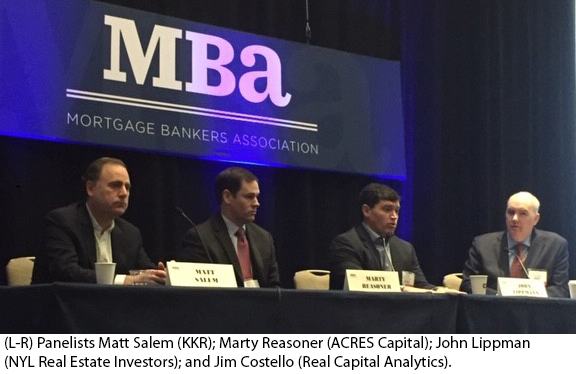
Transitional Lending in a Transitional Economy
SAN DIEGO–Short duration bridge loans on transitional assets are increasingly attractive to lenders due to their higher yields, but these loans come with their own challenges, analysts said here at the MBA CREF/Multifamily Housing Convention & Expo.
“It’s not a risk-free deal,” said Jim Costello, Senior Vice President with Real Capital Analytics, New York. “Though lenders can get higher yields for transitional loans in the bridge space, these are not your everyday properties.”
 In a 2017 white paper, Amherst Capital Management LLC, New York, argued that because lenders generally study an asset’s recent performance to underwrite a loan, they overprice the risk of a vacant or less than fully occupied building remaining that way. “In other words, the market assumes that stabilized fully occupied properties will remain stable forever and non-stabilized have only a small chance to improve–although data suggest otherwise,” Amherst said. The paper called low-leverage loans backed by assets in transition a potential “sweet spot” for lenders in the current market.
In a 2017 white paper, Amherst Capital Management LLC, New York, argued that because lenders generally study an asset’s recent performance to underwrite a loan, they overprice the risk of a vacant or less than fully occupied building remaining that way. “In other words, the market assumes that stabilized fully occupied properties will remain stable forever and non-stabilized have only a small chance to improve–although data suggest otherwise,” Amherst said. The paper called low-leverage loans backed by assets in transition a potential “sweet spot” for lenders in the current market.
Matt Salem, Member and Head of Real Estate Credit with KKR, New York, said bridge lending on transitional assets is a very competitive market. “It’s kind of the flavor of the day right now for investors to get a little bit more yield, so we’ve seen some more capital come into this space,” he said.
But Salem noted most of the increased competition manifests itself in spread compression, not structure or loan size. “We do compete a lot on spreads and spreads have compressed,” he said. “But we’ve not gotten to the next lever yet, which is structure, and we don’t see it on proceeds either. The market is pretty disciplined. They have a long memory from the last downturn that they don’t want to lever up more.”
Salem said problems occur when a property’s equity sponsor holds out for rents that are higher than the market will bear. “That slows down their leasing activity as they wait for what may not be achievable,” he said. “When we think about transitional lending, we focus on the equity’s basis–can they lease at a level that makes sense?”
NYL Real Estate Investors, New York, avoids trouble by focusing on how feasible the business plan is for all players in the capital stack, said NYL REI Senior Director John Lippmann.
“We want to feel good about the equity’s ability to lease the property or complete renovations to lease it up,” he said. “Where you see problems is when the equity has unattainable goals for the property so the leasing at the property stutters. When you look at what can be achieved that’s where we’ve seen as a theme, people get hung up on bridge loans.”
It’s crucial to know the project’s sponsor, said ACRES Capital Partner and Executive Vice President Marty Reasoner. “Is he an expert in this market? We focus on the manager, his experience and does his plan make sense? We are aligned with the sponsor to help the project work. So we help them through the process.”
Reasoner noted ACRES Capital has seen its pipeline grow every year as bridge lending on transitional assets has grown. “We think it’s best to cast a wide net as far as the deals you will look at, then be very selective in which ones you choose,” he said.
